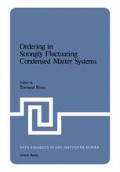Abstract
The random dilution of magnetic crystals with short range interactions provides for experimental investigation of percolation theories, in particular the multiscaling hypothesis for the region close to the percolation point (p = pc, T = 0)[1,2]. Percolation has been intensively studied by series expansion, computer simulation and renormalisation group methods giving numerically well-defined exponents for quantities such as the percolation probability P(p) ∿ (p-pc)βp and the geometric correlation length ξ(p) ∿ p-pc)-νp[3], Many experimentally accessible variables, however, such as correlation functions and excitation spectra cannot easily be calculated by formal renormalisation group techniques and are not reliably given by effective medium type theories. It is valuable, then, to develop scaling models consistent with known critical singularities yet simple enough to allow calculation of such experimentally determined quantities.
Access this chapter
Tax calculation will be finalised at checkout
Purchases are for personal use only
Preview
Unable to display preview. Download preview PDF.
References
R.A. Cowley, R.J. Birgeneau, G. Shirane 1979 (These proceedings).
D. Stauffer 1975 Z. Physik B22 161–71.
A.B. Harris and S. Kirkpatrick 1977 Phys. Rev. B16 542–76.
A.S. Skal and B.I. Shklovskii 1974 Fiz. Tekh. Poluprovdn. 8 1586–92 (Sov. Phys.-Semicond. 8 1029–32).
P.G. de Gennes 1976 J. Physique 37 L1–2.
H.E. Stanley, R.J. Birgeneau, P.J. Reynolds, J.F. Nicoli 1976 J.Phys.C: Solid St. Phys. 9 L553–60.
M.J. Stephen 1978 Phys. Rev. B17 4444–53.
P.G. de Gennes 1972 Physics Letters 38A 339–40.
M.J. Stephen and G.S. Grest 1977 Phys. Rev. Lett. 38 567–70.
D.J. Wallace and A.P. Young 1978 Phys. Rev. B17 2384–7.
T.A.L. Ziman 1979 J.Phys.C: Solid St. Phys. (in press); see also T.A.L. Ziman 1978 D.Phil. Thesis, Oxford University (Unpublished).
T.A.L. Ziman and R.J. Elliott 1978 J.Phys.C: Solid St. Phys. 11, L847–50.
Author information
Authors and Affiliations
Editor information
Editors and Affiliations
Rights and permissions
Copyright information
© 1980 Plenum Press, New York
About this chapter
Cite this chapter
Ziman, T. (1980). Excitations of Dilute Magnets Near the Percolation Threshold. In: Riste, T. (eds) Ordering in Strongly Fluctuating Condensed Matter Systems. NATO Advanced Study Institutes Series, vol 50. Springer, Boston, MA. https://doi.org/10.1007/978-1-4684-3626-6_14
Download citation
DOI: https://doi.org/10.1007/978-1-4684-3626-6_14
Publisher Name: Springer, Boston, MA
Print ISBN: 978-1-4684-3628-0
Online ISBN: 978-1-4684-3626-6
eBook Packages: Springer Book Archive

